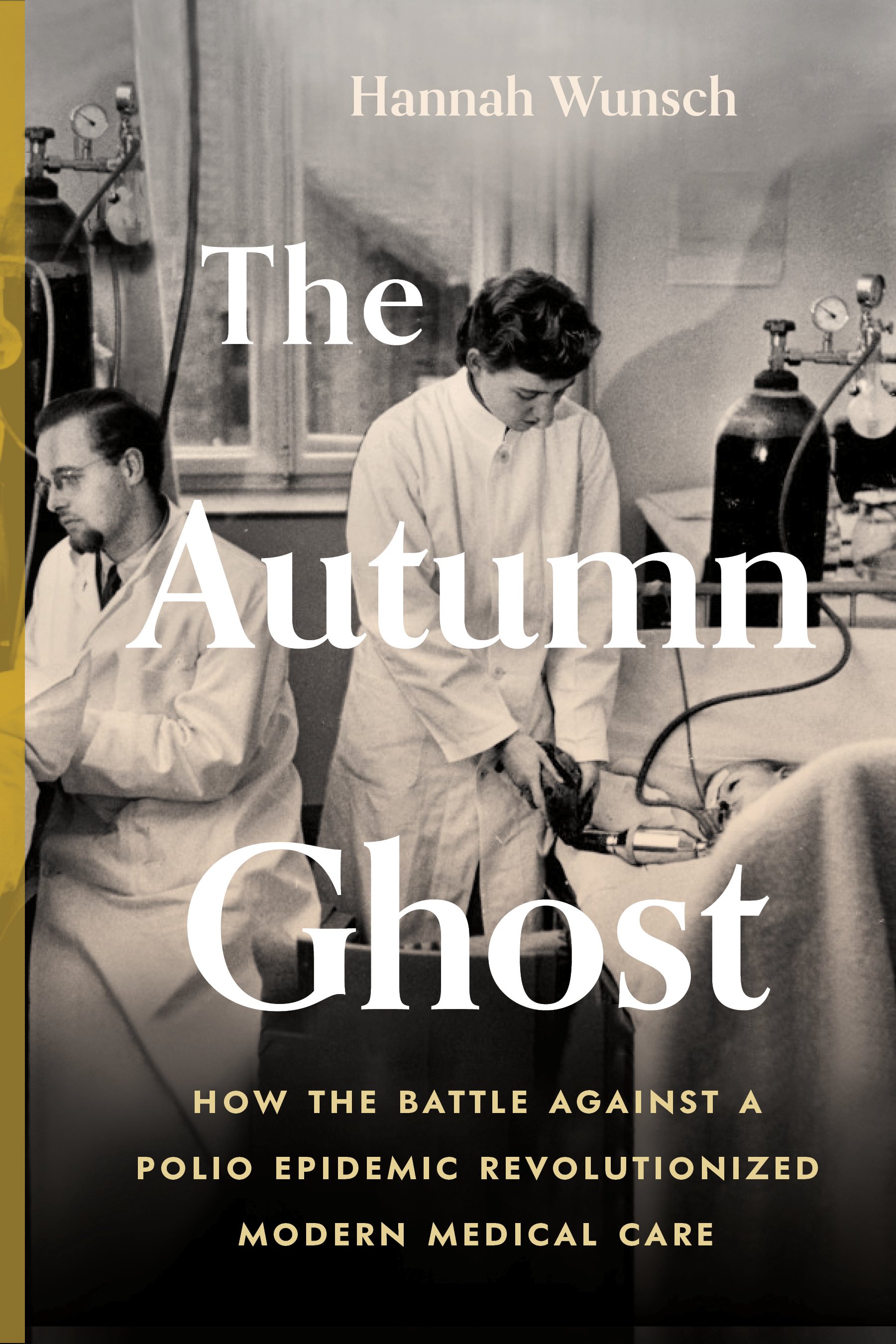#125 How One Polio Epidemic in Denmark Changed Modern Medicine
Reading The Autumn Ghost by Hannah Wunsch
Cover photo provided by Hannah Wunsch
The COVID-19 pandemic naturally got scientists, physicians and members of the public revisiting other catastrophic infectious disease epidemics to see how they were handled by the frightened public and an unprepared society. Hannah Wunsch, MD, a critical care physician and researcher, happened upon a largely untold story of a deadly 1952 polio epidemic in Denmark that fortuitously brought together innovative physicians, dedicated nurses and hundreds of inexperienced medical students to change the treatment of polio and give birth to modern-day intensive care medicine.
For good reasons, many of the historical accounts of the fight against polio have focused on the famous virologists who formulated the life-saving vaccines. Dr. Wunsch’s book “The Autumn Ghost: How the Battle Against a Polio Epidemic Revolutionized Modern Medical Care,” introduces a new cast of heroes and, sadly, some inadvertent villains. In Scandinavia, the polio season was at its worst in September and October, therefore, it was dubbed the “autumn ghost.” The story reads like the most sophisticated and exciting medical mystery ever written.
Dr. Wunsch focuses on one particularly deadly polio strain that struck 1952 Copenhagen, a city that was still struggling with post-World War II shortages and devastation. Faced with staggeringly high death rates of previously healthy children, the local infectious disease hospital, the Blegdam (pronounced bly-dam in Danish), was overrun with critically ill patients. The mortality rate of the admitted polio patients was nearly 90%.
Around-the-clock care
The hospital chief, a renowned infectious disease specialist named Henry Lassen, MD, was by necessity forced to be more creative in the hospital’s approach to caring for dozens of dying patients. Lassen was introduced to Bjorn Ibsen, MD, a pioneer in the new specialty of anesthesiology, and the two were forced into immediate problem-solving mode. Denmark did not have access to the iron lung machines that were used widely in America at the time to treat the respiratory failure symptom of polio.
Ibsen became aware of a little-publicized approach of delivering oxygen to a paralyzed polio patient with positive pressure through a tracheostomy tube. Iron lungs use negative pressure created in a giant metal cannister to expand the rib cage of the patient to allow air to rush in, replicating the mechanism of normal respiration. The paralysis in some polio patients affected the muscles of the rib cage, meaning those patients were unable to breath on their own.
Dr. Ibsen devised a bag valve attachment to allow a person at the bedside to push oxygen into a polio-paralyzed patient. Previously, positive pressure ventilation had not been used outside of short-term stints in the operating room. Dr. Wunsch tells the riveting story of how Dr. Ibsen, who had never even seen a case of polio, improvised using his knowledge of airway control, anesthesia and mechanical ventilation to save a child who was close to her death. His innovative approach led to a rapid change in the way polio patients were treated in the hospital.
At the hospital, there were no machines to take on the arduous and tedious task of breathing all day and night for the polio patients until the infection cleared. Nurses, medical students and dental students in Copenhagen were recruited to perform the vital task of hand-bagging each patient in around-the-clock shifts. Hand-bagging is a manual way to provide positive pressure ventilation. In addition to assuming their pulmonary function, the students talked to their patients and kept the very lonely and frightened children company while they were separated from their families.
Dr. Wunsch weaves in the stories of individual children, caregivers and physicians into this incredibly well-researched account. She has included their pictures and the recollections that she has gathered through research and interviews with survivors. The dedicated crew of physicians, nurses and students still lost some of their dear patients, but the mortality rate of the most serious forms of polio were significantly diminished from 87% to 11% in a matter of months. (page 215)
“These numbers were astonishing-few new medical interventions have ever made such a big difference to the death rate from a disease in such a short period of time. Lassen wasted no time in sharing these results…Lassen went straight to The Lancet, a major international journal with a huge readership where the paper was published on January 3, 1953.” (page 216)
The experiences from the Copenhagen epidemic of 1952 changed the treatment of polio and was extended to other forms of respiratory failure and insufficiency. The invention and development of mechanical ventilators, termed “mechanical students,” was jump-started and refined in Sweden and the United Kingdom. The use of blood gases and the importance of acid-base balance were also advanced by this one pivotal and innovative medical experiment.
Dr. Ibsen later took a position at the Municipal Hospital in Copenhagen and became the first Chief of the newly formed Department of Anesthesia in 1954. What he learned from the treatment of polio and devised a new type of acute care—specialized units that treated extremely ill patients with one or more severely affected organ systems.
“On July 1, 1953, Ibsen opened a ten-bed “recovery room” for surgical patients who needed additional support and attention…By December of that year, he had it staffed twenty-four hours a day. In an important change to who would receive “intensive care,” Ibsen accepted a first “non-surgical” patient, opening up the unit for the care of any and all who were critically ill… this recovery room is widely considered the first true intensive care unit. (ICU).” (pages 236-237)
Advances in Technology
Paradoxically, the reliance on and investment in the use of the iron lung in the United States placed it several years behind in the development of positive pressure ventilators and critical care units. Within a decade, the Americans had caught up. Many of the routine practices of blood gas analysis and ventilator technology physicians now use frequently stemmed from this one terrible polio epidemic.
In addition to the development of the modern ICU, the survival of polio patients stimulated the development of physical therapy and rehabilitation medicine in Denmark and around the world. The public health system in Denmark stepped forward to sponsor seaside rehabilitation facilities for the affected children and lifelong care for the 25 or so people who became ventilator-dependent for their entire lives. A special apartment building was designed and constructed where these people could live and receive lifelong care.
The author followed the complicated careers and relationships of the physicians who collaborated on the innovations of care during the epidemic. The competitive and elitist nature of academic medicine often seemed to work against achieving shared goals. The stories of petty disagreements between Drs. Lassen and Ibsen and their jockeying for academic acclaim were an unfortunate postscript to what can only be described as an incredible team accomplishment to save the most vulnerable children and adults in Danish society.
Dr. Wunsch cleverly combines the details of medical literature, medical politics, and explanations of medical practice with the experiences and images of individual patients. Several patients shared how their lives progressed after leaving the Blegdam. The author travelled to Denmark to interview several surviving patients and one of the hand-ventilating medical students who was inspired by her experience to become an anesthesiologist. Sadly, all the polio survivors Dr. Wunsch interviewed have some form of disability due to post-polio syndrome.
“In the process of researching and writing this book, I also came to understand that polio as a disease had a reach that was broader than just intensive care,” said Dr. Wunsch. “This one disease had an enormous societal impact, influencing approaches to disease prevention, rehabilitation, long-term illness and rights for individuals. As I write this, I fervently hope that the polio epidemics of the past that spurred all this innovation remain squarely in that past.” (pg. 296)


